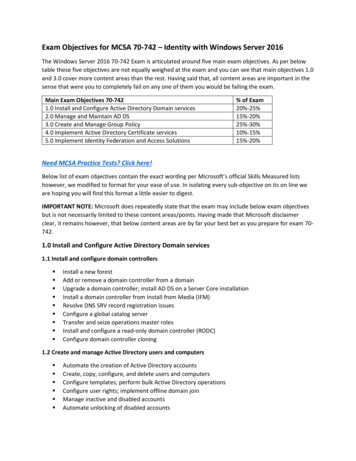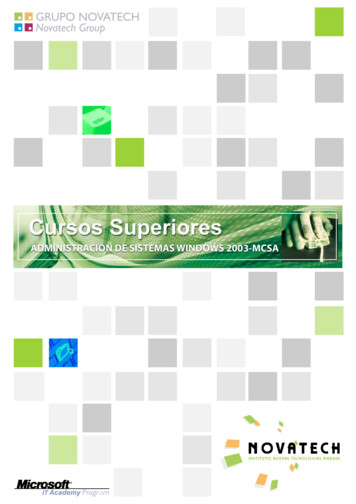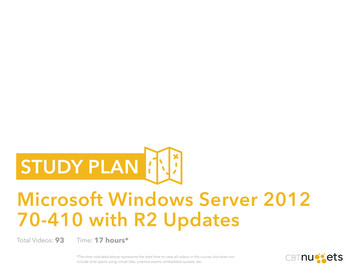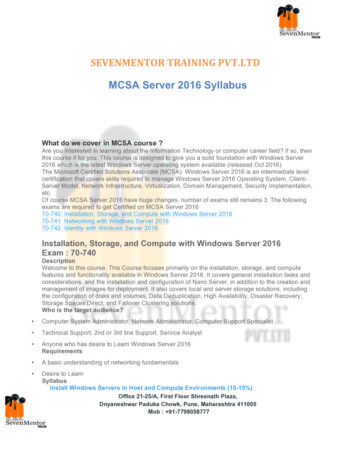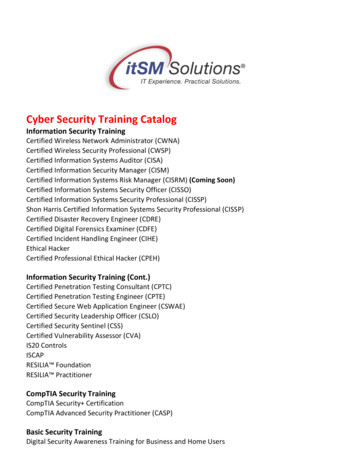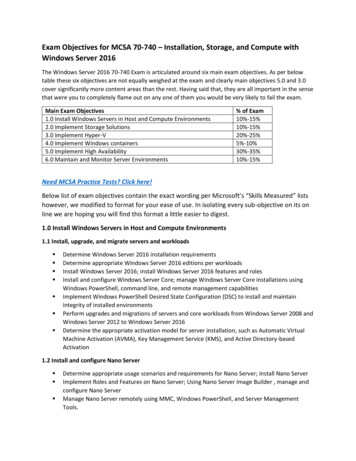
Transcription
Exam Objectives for MCSA 70-740 – Installation, Storage, and Compute withWindows Server 2016The Windows Server 2016 70-740 Exam is articulated around six main exam objectives. As per belowtable these six objectives are not equally weighed at the exam and clearly main objectives 5.0 and 3.0cover significantly more content areas than the rest. Having said that, they are all important in the sensethat were you to completely flame out on any one of them you would be very likely to fail the exam.Main Exam Objectives1.0 Install Windows Servers in Host and Compute Environments2.0 Implement Storage Solutions3.0 Implement Hyper-V4.0 Implement Windows containers5.0 Implement High Availability6.0 Maintain and Monitor Server Environments% of Exam10%-15%10%-15%20%-25%5%-10%30%-35%10%-15%Need MCSA Practice Tests? Click here!Below list of exam objectives contain the exact wording per Microsoft’s “Skills Measured” listshowever, we modified to format for your ease of use. In isolating every sub-objective on its online we are hoping you will find this format a little easier to digest.1.0 Install Windows Servers in Host and Compute Environments1.1 Install, upgrade, and migrate servers and workloads Determine Windows Server 2016 installation requirementsDetermine appropriate Windows Server 2016 editions per workloadsInstall Windows Server 2016; install Windows Server 2016 features and rolesInstall and configure Windows Server Core; manage Windows Server Core installations usingWindows PowerShell, command line, and remote management capabilitiesImplement Windows PowerShell Desired State Configuration (DSC) to install and maintainintegrity of installed environmentsPerform upgrades and migrations of servers and core workloads from Windows Server 2008 andWindows Server 2012 to Windows Server 2016Determine the appropriate activation model for server installation, such as Automatic VirtualMachine Activation (AVMA), Key Management Service (KMS), and Active Directory-basedActivation1.2 Install and configure Nano Server Determine appropriate usage scenarios and requirements for Nano Server; install Nano ServerImplement Roles and Features on Nano Server; Using Nano Server Image Builder , manage andconfigure Nano ServerManage Nano Server remotely using MMC, Windows PowerShell, and Server ManagementTools.
1.3 Create, manage, and maintain images for deployment Plan for Windows Server virtualizationAssess virtualization workloads using the Microsoft Assessment and Planning (MAP) ToolkitDetermine considerations for deploying workloads into virtualized environmentsUpdate images with patches, hotfixes, last cumulative updates and driversInstall roles and features in offline images; manage and maintain Windows Server Core, NanoServer images, and VHDs using Windows PowerShell2.0 Implement Storage Solutions2.1 Configure disks and volumes Configure sector sizes appropriate for various workloadsConfigure GUID partition table (GPT) disksCreate VHD and VHDX files using Disk Management or Windows PowerShellMount virtual hard disksDetermine when to use NTFS and ReFS file systemsConfigure NFS and SMB shares using Server ManagerConfigure SMB share and session settings using Windows PowerShellConfigure SMB server and SMB client configuration settings using Windows PowerShellConfigure file and folder permissions2.2 Implement server storage Configure storage poolsImplement simple, mirror, and parity storage layout options for disks or enclosuresExpand storage poolsConfigure Tiered Storage; configure iSCSI target and initiatorConfigure iSNSConfigure Datacenter Bridging (DCB)Configure Multi-Path IO (MPIO)Determine usage scenarios for Storage ReplicaImplement Storage Replica for server-to server, cluster-to-cluster, and stretch cluster scenarios2.3 Implement data deduplication Implement and configure deduplicationDetermine appropriate usage scenarios for deduplicationMonitor deduplicationImplement a backup and restore solution with deduplication3.0 Implement Hyper-V3.1 Install and configure Hyper-VDetermine hardware and compatibility requirements for installing Hyper-V; install Hyper-V; installmanagement tools; upgrade from existing versions of Hyper-V; delegate virtual machine management;
perform remote management of Hyper-V hosts; Using Windows PowerShell Direct; implement nestedvirtualization3.2 Configure virtual machine (VM) settings Add or remove memory in a running VMConfigure dynamic memoryConfigure NonUniform Memory Access (NUMA) supportConfigure smart paging; configure Resource MeteringManage Integration ServicesCreate and configure Generation 1 and 2 VMs and determine appropriate usage scenariosImplement enhanced session mode; create Linux and FreeBSD VMsInstall and configure Linux Integration Services (LIS)Install and configure FreeBSD Integration Services (BIS)Implement Secure Boot for Windows and Linux environmentsMove and convert VMs from previous versions of Hyper-V to Windows Server 2016 Hyper-VExport and import VMsImplement Discrete Device Assignment (DDA), Troubleshoot VM configuration versions3.3 Configure Hyper-V storage Create VHDs and VHDX files using Hyper-V ManagerCreate shared VHDX filesConfigure differencing disks; modify virtual hard disksConfigure pass-through disksResize a virtual hard diskManage checkpointsImplement production checkpointsImplement a virtual Fiber Channel adapterConfigure storage Quality of Service (QoS)3.4 Configure Hyper-V networking Add and remove virtual network interface cards (vNICsConfigure Hyper-V virtual switchesOptimize network performanceConfigure MAC addressesConfigure network isolationConfigure synthetic and legacy virtual network adaptersConfigure NIC teaming in VMsConfigure virtual machine queue (VMQ)Enable Remote Direct Memory Access (RDMA) on network adapters bound to a Hyper-V virtualswitch using Switch Embedded Teaming (SET)Configure Bandwidth Management4.0 Implement Windows containers4.1 Deploy Windows containers
Determine installation requirements and appropriate scenarios for Windows ContainersInstall and configure Windows Server container host in physical or virtualized environmentsInstall and configure Windows Server container host to Windows Server Core or Nano Server ina physical or virtualized environmentInstall Docker on Windows Server and Nano ServerConfigure Docker start-up optionsInstall PowerShell for DockerInstall a base container imageTag an imageRemove a containerCreate Windows Server containersCreate Hyper-V containers4.2 Manage Windows containers Manage Windows containers by using Docker CLI and PowerShell for DockerManage container networkingManage container data volumesManage Resource ControlCreate new container images using DockerfileManage container images using DockerHub repository for public and private scenariosManage container images using Microsoft Azure5.0 Implement High Availability5.1 Implement high availability and disaster recovery options in Hyper-V Implement Hyper-V ReplicaImplement Live Migration including Shared Nothing Live MigrationConfigure CredSSP or Kerberos authentication protocol for Live MigrationImplement storage migration5.2 Implement failover clustering Implement Workgroup, Single, and Multi Domain clusters; configure quorumConfigure cluster networking; restore single node or cluster configurationConfigure cluster storage; implement Cluster-Aware UpdatingImplement Cluster Operating System Rolling UpgradeConfigure and optimize cluster shared volumes (CSVs)Configure clusters without network namesImplement Scale-Out File Server (SoFS)Determine different scenarios for the use of SoFS vs. File Server for general useDetermine usage scenarios for implementing guest clusteringImplement a Clustered Storage Spaces solution using Shared SAS storage enclosuresImplement Storage ReplicaImplement Cloud Witness; implement VM resiliencyImplement shared VHDX as a storage solution for guest clusters
5.3 Implement Storage Spaces Direct Determine scenario requirements for implementing Storage Spaces DirectEnable Storage Spaces Direct using Windows PowerShellImplement a disaggregated Storage Spaces Direct scenarioImplement a hyper-converged Storage Spaces Direct scenario5.4 Manage failover clustering Configure role-specific settingsIncluding continuously available sharesConfigure VM monitoringConfigure failover and preference settingsImplement stretch and site-aware failover clustersEnable and configure node fairness5.5 Manage VM movement in clustered nodes Perform a live migration; perform a quick migrationPerform a storage migrationImport, export, and copy VMs; configure VM network health protectionConfigure drain on shutdown5.6 Implement Network Load Balancing (NLB) Install NLB nodesConfigure NLB prerequisitesConfigure affinityConfigure port rulesConfigure cluster operation modeUpgrade an NLB cluster6.0 Maintain and Monitor Server Environments6.1 Maintain server installations Implement Windows Server Update Services (WSUS) solutionsConfigure WSUS groupsManage patch management in mixed environmentsImplement an antimalware solution with Windows DefenderIntegrate Windows Defender with WSUS and Windows UpdatePerform backup and restore operations using Windows Server BackupDetermine backup strategies for different Windows Server roles and workloads, includingHyper-V Host, Hyper-V Guests, Active Directory, File Servers, and Web Servers using WindowsServer 2016 native tools and solutions6.1 Monitor server installations
Monitor workloads using Performance Monitor, Server Manager, Event ViewerConfigure Data Collector Sets; determine appropriate CPU, memory, disk, and networkingcounters for storage and compute workloadsConfigure alertsMonitor workloads using Resource MonitorNeed MCSA Practice Tests? Click here!
Manage container images using DockerHub repository for public and private scenarios Manage container images using Microsoft Azure 5.0 Implement High Availability 5.1 Implement high availability and disaster recovery options in Hyper-V Implement Hyper-V Replica Implement Live Migration including Shared Nothing Live Migration
